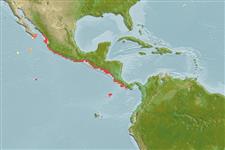Teleostei (teleosts) >
Eupercaria/misc (Various families in series Eupercaria) >
Lutjanidae (Snappers) > Lutjaninae
Etymology: Lutjanus: Malay, ikan lutjan, name of a fish.
More on author: Peters.
Environment: milieu / climate zone / depth range / distribution range
Ecology
Marine; reef-associated; depth range ? - 40 m (Ref. 9313). Tropical; 24°N - 4°N, 118°W - 82°W (Ref. 55)
Eastern Pacific: Mexico to Panama. Included in the genus Rabiruba Jordan & Fesler by some authors.
Size / Weight / Age
Maturity: Lm ? range ? - ? cm
Max length : 34.0 cm TL male/unsexed; (Ref. 9313)
Dorsal spines (total): 10; Dorsal soft rays (total): 13; Anal spines: 3; Anal soft rays: 11. Snout very pointed. Mouth relatively small, the maxilla extending to front of eye. Eyes large, about 4 times in head length. Preopercular notch and knob weak. Scale rows on back rising obliquely above lateral line. Live coloration unknown.
Adults inhabit coastal rocky and coral reefs up to at least 40 m depth (Ref. 9313). During the day they form schools of 30 or more individuals, which sometimes remain stationary (Ref. 9313). Juveniles are seen associated with schools of Chromis atrilobata (Ref. 9313). Feed on invertebrates and fish and may also ingest plankton (Ref.9313). Marketed fresh and frozen (Ref. 9313).
Life cycle and mating behavior
Maturities | Reproduction | Spawnings | Egg(s) | Fecundities | Larvae
Allen, G.R., 1985. FAO Species Catalogue. Vol. 6. Snappers of the world. An annotated and illustrated catalogue of lutjanid species known to date. FAO Fish. Synop. 125(6):208 p. Rome: FAO. (Ref. 55)
IUCN Red List Status (Ref. 130435)
Threat to humans
Harmless
Human uses
Fisheries: of potential interest; gamefish: yes
Tools
Special reports
Download XML
Internet sources
Estimates based on models
Preferred temperature (Ref.
123201): 25.3 - 28.7, mean 27.6 °C (based on 16 cells).
Phylogenetic diversity index (Ref.
82804): PD
50 = 0.5000 [Uniqueness, from 0.5 = low to 2.0 = high].
Bayesian length-weight: a=0.01479 (0.00706 - 0.03101), b=2.97 (2.81 - 3.13), in cm total length, based on LWR estimates for this Genus-body shape (Ref.
93245).
Trophic level (Ref.
69278): 3.8 ±0.57 se; based on food items.
Resilience (Ref.
120179): High, minimum population doubling time less than 15 months (Preliminary K or Fecundity).
Fishing Vulnerability (Ref.
59153): Low vulnerability (24 of 100).
Nutrients (Ref.
124155): Calcium = 46.4 [27.5, 73.8] mg/100g; Iron = 0.414 [0.265, 0.689] mg/100g; Protein = 18.3 [16.8, 19.6] %; Omega3 = 0.131 [0.086, 0.202] g/100g; Selenium = 50 [29, 86] μg/100g; VitaminA = 243 [46, 1,007] μg/100g; Zinc = 0.47 [0.35, 0.68] mg/100g (wet weight);
